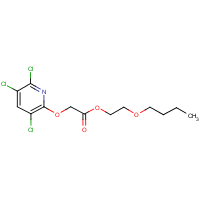Triclopyr-butotyl
Agent Name
Triclopyr-butotyl
Alternative Name
Triclopyr BEE
CAS Number
64700-56-7
Formula
C13-H16-Cl3-N-O4
Major Category
Pesticides

Synonyms
Triclopyr BEE; ((3,5,6-Trichloro-2-pyridinyl)oxy)acetic acid 2-butoxyethyl ester; (3,5,6-Trichloro-2-pyridinyl)oxyacetic acid, butoxyethyl ester; Garlon 4; Garlon 4E; M 4021; 2-Butoxyethyl ((3,5,6-trichloropyridin-2-yl)oxy)acetate; Acetic acid, ((3,5,6-trichloro-2-pyridinyl)oxy)-, 2-butoxyethyl ester; Butoxyethyl triclopyr; [ChemIDplus] Garlon; Pathfinder; Remedy; Turflon; [Merck Index]
Category
Herbicides, Other
Description
Brown oily liquid; [ICSC] Liquid; Formulated as emulsifiable concentrate, liquid, granular, and formulation intermediate; [Reference #1]
Sources/Uses
Used as systemic herbicide for control of broad-leaved weeds and woody plants in rice, range and pastureland, rights-of-way, forestry, and turf (including residential lawns and gardens); [Reference #1]
Comments
A mild eye irritant; May cause skin sensitization; [ICSC] Hepatotoxic and skin sensitizer in animal studies; The free acid, triethylamine salt, and butoxyethyl ester are considered bioequivalent except for acute toxicity; [Reference #1] Causes changes in kidney weight and normocytic anemia in 90-day intermittent oral study of rats; [RTECS] See "Triclopyr."
Reference Link #1
Biomedical References
Exposure Assessment
Vapor Pressure
7.92E-07 mm Hg
Lethal Concentration
LC50 (rat) > 4,800 mg/m3
Adverse Effects
Skin Sensitizer
Yes
Hepatotoxin
Hepatoxic (a) from occupational exposure (secondary effect) or (b) in animal studies or in humans after ingestion
Diseases, Processes, and Activities Linked to This Agent
Diseases
Occupational diseases associated with exposure to this agent:
Processes
Industrial Processes with risk of exposure: